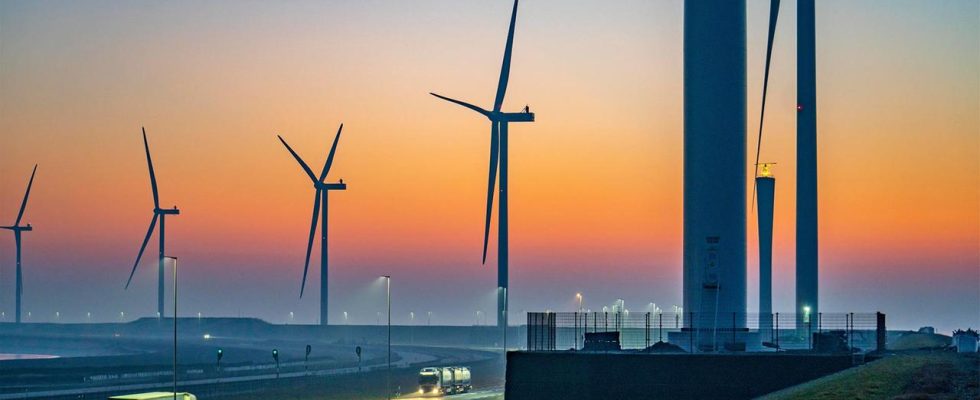Europe’s new hydrogen bank will award up to 800 million euros in funding to producers of “green” hydrogen in its first auction. Rotterdam wants to become a hub. The material is vital for German steelworks.
From the dune at the far end of the Rotterdam harbor, Randolf Weterings has a magnificent view of the energy transition: on the right, the old coal-fired power station, with gray smoke pouring out of its chimneys, next to it, the large wind turbine and the converter station, where electricity from the wind farms in the North Sea reaches land . In the newest port terminal, Maasvlakte 2, Europe’s energy future is only slowly taking shape.
As manager of the port administration, Weterings is responsible for this: “Rotterdam wants to become the hydrogen hub for Europe,” he says. “We are already the energy hub for Europe – around 13 percent of annual energy consumption comes through the port of Rotterdam. We want to fill this role with hydrogen in the future.”
Electrolyzers on the artificial island
Maasvlakte 2 is an artificial island that the port administration reclaimed from the sea. Kite surfers practice on the beach behind the dune, excavators operate within the fenced area and cranes lean over half-finished buildings. Here we are literally building on sand.
The energy company Shell, which grew up with fossil fuels, wants to build Europe’s largest hydrogen plant on the site in the next two years. It is expected to deliver up to 60,000 kilograms per day. Three other companies are also building electrolyzers that convert water into hydrogen using – if possible “green” – electricity. There is still little to see apart from a few halls and concrete areas.
Pipelines to Germany
“The challenge for the hydrogen economy is that everything has to be there at the same time,” explains port manager Weterings. “We have to start production, build pipelines and change usage. In the end we have to expand the whole system – in the Netherlands and towards Germany.”
The port of Rotterdam wants to handle almost five million tons of hydrogen by 2030, and by 2050 it should be four times as much. The majority, 90 percent, will not be produced in Rotterdam in the future, but will be imported to Europe via the port. Pipelines will connect it with chemical companies and steelworks in Germany.
Waiting for the material
At the Salzgitter steelworks they are hoping for hydrogen from the North Sea coast. The heart of production is the hot strip mill: Here, a meter-long red-hot rectangle, the so-called slab, is rolled out in several stations into a long, flat steel strip and cooled with water in between. Heavy industry like this has made Germany great as a location.
In order for it to stay that way, a lot has to change. Gunnar Groebler is the CEO of the second largest German steel manufacturer after ThyssenKrupp. Lower Saxony wants to be number one when it comes to sustainability: “We made the investment decision last year and will now replace the first blast furnace with new technology based on electricity and hydrogen and thus produce green steel at the Salzgitter site from 2026. For Salzgitter AG “This is a future project to help us emerge from the transformation stronger.”
Doomed to success
Germany’s steel producers are doomed to success. Their systems emit a particularly large amount of climate-damaging greenhouse gases. They are responsible for seven percent of German emissions. One percent of Germany’s emissions come from Salzgitter alone, where they pump eight million tons of carbon dioxide into the air every year.
But that also means that you can save a lot here. In Salzgitter they are using a new reduction technology. This is the name of the process for extracting iron from iron ore. By switching from coke to natural gas and most recently to hydrogen in direct reduction, Salzgitter wants to reduce CO2 emissions by 95 percent in ten years.
A test oven and our own hydrogen production have been running for several years. Now the green steelworks of the future is being built against the mighty brown-gray backdrop of the old steelworks. The hydrogen we produce ourselves is far from enough for this: Salzgitter produces around 9,000 tons a year with a planned new plant. However, 300,000 tons will be needed for green steel production in the final expansion stage.
“We urgently need the infrastructure”
The responsible division manager Ulrich Grethe calls on politicians to finally solve the chicken-and-egg problem: “The producer waits until the consumer is actually there and we as consumers wait until a reliable source of hydrogen is available. We have “There are still no hydrogen procurement contracts. They don’t even exist yet. That’s why we so urgently need the infrastructure in between.”
In ten years there will no longer be any blast furnaces in Salzgitter, only plants for green steel. Network operators are working hard on lines for “green” electricity and “green” hydrogen from the North Sea coast – a huge bet on the future with an open outcome. Time is running out.
Jakob Mayr, ARD Brussels, tagesschau, November 23rd, 2023 9:24 a.m

